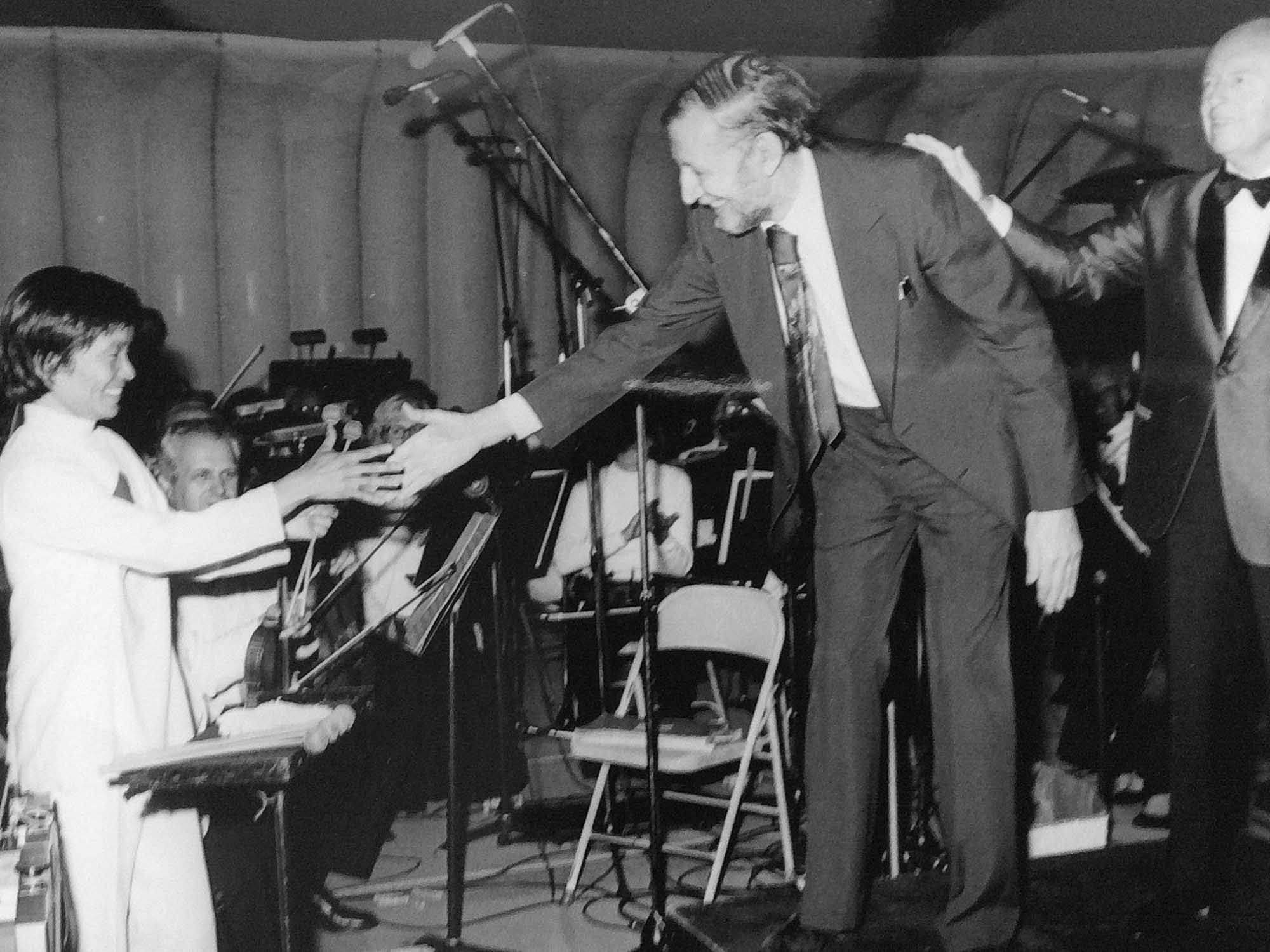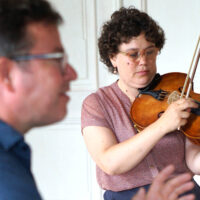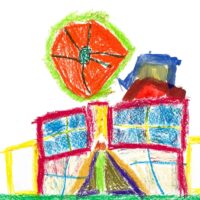Alan Hovhaness was exposed to the most varied influences when he created his symphonies. His music is transcultural and anticipates future togetherness.
People in the Old World often think that good music and eminent achievements can only come from the old Europe. This is certainly not true for popular music, but with composed symphonic music, the range remains narrow. At most, there may be a symphony by Charles Ives (1874–1954) as a typically American curiosity, not on a par with the body of symphonic music to be taken seriously. European audiences of symphonic concerts seem surprised that the New World yielded any music able to articulate itself boldly, free from the constraints of European post-war modernism even before Arvo Pärt (Estonia), Henryk Górecki (Poland), Giya Kancheli (Georgia), and Einojuhani Rautavaara (Finland), for hardly any of it ever enters the conventional concert programs. The fact that there is symphonic music that reflects the situation on the North American continent and embraces its breadth and diversity seems to be beyond the imagination of European concert halls, which therefore remain largely closed to it. There may be one or the other symphony by Leonard Bernstein or Aaron Copland, but what about William Schuman, Samuel Barber, Roy Harris, Roger Session? What kind of music conceals itself behind names such as Henry Cowell or Elliott Carter? And who on earth is Alan Hovhaness—this most prolific composer of Armenian roots whose indefatigable musical productivity seemed inspired by the vastness of the North American continent? I discovered Alan Hovhaness in my search for symphonic grandmasters of the twentieth and twenty-first centuries and had to berate myself for having ignored someone like him. “He composed too much—one doesn’t know where to start and might get lost.” His output, in fact, amounted to more than 500 works.
Alan Vaness Chakmakjian was born in Somerville, Massachusetts, on North America’s east coast on March 8th, 1911, to Scottish Madeline Scott and Haroutioun Hovanes Chakmakjian, who was of Armenian descent. In 1931, he took on the surname Hovaness, which he officially changed to Hovhaness in 1940. From then on, he engaged intensively with Armenian culture and music. He worked, among other things, as an organist at the St. James Armenian Apostolic Church in Watertown (Massachusetts), where he was exposed to Armenian music and culture. In his childhood home, he had come across Komitas Vartapet (1869–1935), the saviour of Armenian music. It was thanks to Komitas that this music was kept alive during the Armenian genocide by the Ottomans (from 1915) and that it continues to be cultivated in the diaspora around the world. “When I was growing up, my father had this wonderful record of choral music by the Armenian composer Komitas. To me, he’s the original minimalist, and it was through Komitas that I got the idea of saying as much as possible with the fewest possible notes.”
Transcultural
Among Alan Hovhaness’ numerous symphonies, there is No. 23, Op. 249 (1972), entitled Ani—the city of a thousand and one cathedrals, the capital of the former Armenian kingdom that was destroyed in the Middle Ages. This symphony, composed for wind orchestra, is a brilliant example of Alan Hovhaness’ musical language. He often uses the names of mountains as titles for his symphonies, for instance, Mount St. Helens for Symphony No. 50, Op. 360 (1982), a volcano that had become active again in 1980. Symphony No. 60, Op. 396 (1985) bears the name To the Appalachian Mountains. Symphony No. 14, Op. 194 (1960) is called Ararat after the landing place of Noah’s Ark and Armenia’s holy mountain. Mysterious Mountains is the name of Symphony No. 2, Op. 132 (1955). Many of Alan Hovhaness’ works seem to relate to archaic-mythical images. The music is approachable and accessible; it seems both strangely familiar and unmistakeably original. The composition Khrimian Hairig, Op. 49 (1944/1948), lasts for about eight minutes, in which it conveys the basic mood mentioned, allowing the listener to enter emotionally into such mythical spheres.
Alan Hovhaness’ music is transcultural in that it opens itself to diverse musical forms of expression. In addition to his Armenian roots, he was strongly influenced by Indian, Japanese, Korean, Hawaiian, and other cultures, all of which he absorbed and deepened as he travelled and studied those countries. Through adaptation and transformation, elements were absorbed into his own tonal language, newly formulated and made to resonate. Using the example of Fantasy on Japanese Woodprints Op. 211 (1965), it can be shown that while the mood of Japanese music is clearly present, this work is not copied or collaged but emerges as an independent tonal language that includes Japanese particularities. One cannot avoid using the term “transcultural,” which is wonderfully self-explanatory here. Instead of amalgamating elements from different cultures in a kind of polystylism or multiculturality, Hovhaness combines essential aspects of diverse musical cultures into his own individual musical style. One could also call it a musical mixed marriage, where the diverse elements unite organically to give rise to something new that did not exist before. This kind of transculturality clearly differs from the uniformity of the sound wallpaper one is exposed to in airports around the world. “The high quality of this music, the purity of its inspiration, is evidenced by the extreme beauty of its melodic material (which is original material, not collected folklore) and in the perfect sweetness of taste it leaves in the mouth. There is no vulgarity in it, nothing meretricious, silly, easy, or of low intent. It brings delight to the ear and pleasure to the thought” (Virgil Thomson).
Reception
The reception of Alan Hovhaness’ oeuvre ranges from highly appreciative voices, like the one cited above, to contempt and rejection. Leonard Bernstein and Aaron Copland, for instance, during the recording of Hovhaness’ 1st symphony (Exile Symphony), loudly voiced their aversion to such “cheap ghetto music,” causing Hovhaness to immediately withdraw. Among his prominent advocates and supporters were Martha Graham (1894-1991), the grande dame of modern dance, and the inventive and productive avant-garde musician John Cage (1912-1992). The dissemination of Alan Hovhaness’ work on the American continent is remarkable. In the last third of his life, Hovhaness concentrated mostly on the Northwest, settling in Seattle, where he died on June 21st, 2000. His partner Hinako Fujihara Hovhaness (1932-2022) was devoted to disseminating his work.
Those who engage more deeply with the work of Alan Hovhaness will discover wonderful qualities that are highly relevant in our time. The recent radical hardening of idealogical fronts, the new scars and flaring up of crude anti-Semitism, and other racist positions and pronouncements call for vigilance and circumspection. Only 33 nations so far have recognized the genocide of the Armenian people mentioned earlier. The perpetrating nation, or its successor, is not among them. These facts tend to be either completely ignored or considered irrelevant. In my gradual discovery of Alan Hovhaness’ extensive oeuvre, I am struck again and again with the immediate effectiveness of music. His statement, “My purpose is not to create music for snobs, but for all people, music which is beautiful and healing. To attempt what old Chinese painters called ‘spirit resonance’ in melody and sound,” contrasts markedly with the complex of antisemitism, racism, genocide and contempt for humanity cited above. With his life’s work, Alan Hovhaness has created something that aims to further the transcultural development of humanity. This it achieves to an initially modest extent wherever it has the chance to be heard. I am convinced that if we open the door to such transcultural achievements by nurturing and promoting them, the world will become a little more humane.
Translation Margot M. Saar
Image At the concert ‘Fantasy on Japanese Woodprints’ left: Sasaki, centre: Alan Hovhaness, 1975. Source: CC BY-SA 4.0.






It might be interesting to know that Hovhaness was also a Rosicrucian, a member of AMORC. I corresponded with him once, to invite him to an event, and he told me that he joined because of their research on Francis Bacon, who was an influence on his life. A lovely man who wrote spiritual music!